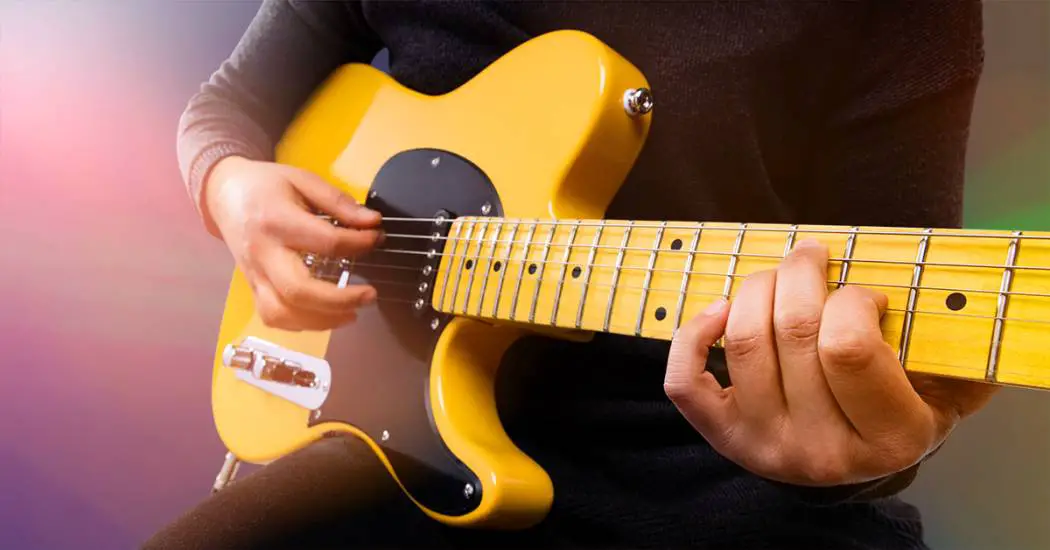Imagine wanting to accomplish something because you love it so deeply, but your physical attributes make you feel constrained. Many of us would like to learn how to play the guitar, but the issue of our fingers being either too short or too fat keeps getting in the way.
In actuality, the size of your fingers does matter when playing the guitar. Because of this, there are many different guitars available in a range of sizes and forms to accommodate a variety of players.
Therefore, you should choose a guitar that fits your hand size in order to get the most out of it. However, I must admit that a player’s talent cannot be compared to anything. You can get past having to choose a certain guitar to fit your fingers as you advance.
After working as a coach for some time, I have noticed that the majority of my beginners always complain that their fingers aren’t suitable for playing the guitar.
For them to get over their concerns about finger size and guitar playing, I usually take my time to clarify certain aspects. These are what I would actually be revealed to us in this post.
Does Finger Size Actually Affect Guitar Playing?
Finger size does actually affect guitar playing – some chord grips are more difficult for those with smaller hands than typical.
People who have longer, thinner fingers will learn to play the guitar very differently than others who have shorter, thicker fingers.
Because of this, there are many different guitars available in a range of sizes and forms to accommodate a variety of players. Therefore, you should choose a guitar that fits your hand size in order to get the most out of it.
However, many well-known guitarists, including Andres Segovia, use a guitar style that is inappropriate for their hand size.
He performs on a full-sized classical guitar and has short, thick fingers. This means you can actually decide not to allow your finger size to affect the way you play.
What Type of Fingers Are Best for Guitar Playing?
Longer fingers are generally better for guitar playing. This is because they can play long chords that are located low on the fretboard.
Without having to shift their hand up and down the fretboard, they may find it simpler to span more frets.
But everything that has a pro also has a disadvantage. A full barre chord could be a little trickier for beginners with lengthy fingers due to reduced leverage.
However, partial barres might be simpler to play for persons with fatter fingertips. They might discover the “finger roll,” which involves switching between notes on the same fret of adjacent strings, to be simpler.
The problem is that bigger or fatter fingers have a greater surface area on their tips, which makes it harder for the fretting hand to control strings on instruments with close-spaced strings, such as an electric guitar.
This may slightly hinder a player, but as long as their fingers are well-trained and thus nimble and dexterous, they shouldn’t experience any issues over time.
For short fingers, even though they may have more leverage for full barre chords, they won’t be able to reach as many frets, especially on the bass guitar because of its further apart frets.
I personally suggest not becoming overly upset or accepting challenges brought on by your fingers. It has not stopped people from playing instruments they want to play, like “the bass,” and I’m sure it won’t stop you either.
4 Tips For Guitar Players With Short Fingers
1. Choose a Comfortable Neck
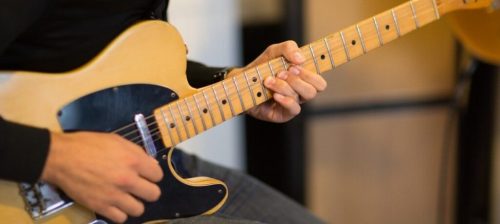
Choosing comfortable guitar neck is one of the best option if you have small fingers
Choosing a guitar with a shorter neck is the ideal option if you have small hands. You’ll find it simpler to hold the strings and apply pressure if the neck is narrower or slimmer.
The typical width of an acoustic guitar’s neck is 1.73 inches (44mm), compared to under 1.7 inches for an electric guitar and 2 inches for a classical guitar.
For those with small hands, a C-shaped neck is ideal since it provides a stronger grip. U-shaped or D-shaped necks, on the other hand, are wider and are not advised for persons with short hands.
2. Stretch Your Fingers Regularly
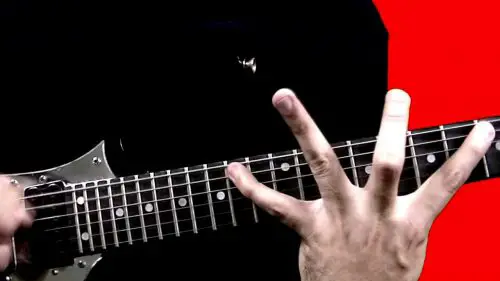
Before playing guitar you must need to warm your fingers first
Warming up your fingers before playing is a further important piece of advice for guitarists with small hands. It’s important to loosen up your fingers before playing guitar, much like athletes need to stretch before working out.
You will initially feel as though you’re continuously silencing and muting sounds. Perhaps you’ll blame your small hands because the strings are too distant to reach!
Regular finger stretching will help your muscles adapt to playing the guitar and eventually develop dexterity. It will make it simpler for you to reach the chords and notes you want to play with and will help reduce hand soreness.
3. Use Lighter Gauge Strings
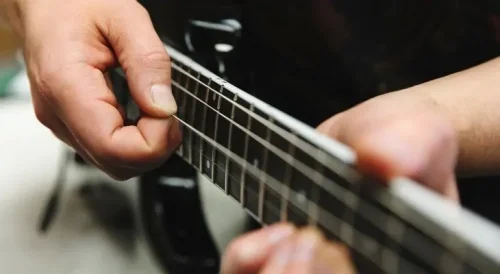
You must need skinnier strings if you have lighter string gauge
Another factor is the thickness of the guitar strings. The strings will be skinnier if the string gauge is lighter.
This should reduce strain or any problems with your fingers’ length and make it easier to hold the strings down. Even if you are unsure, you can test a lighter gauge to determine if it’s a good alternative.
4. Keep Thumb Behind Guitar Neck
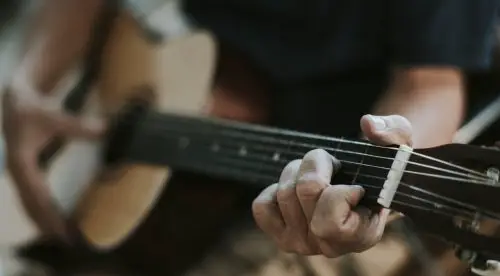
For good gripping you should need to keep your thumbs behind the guitar neck
For those with short fingers, try as much as possible to avoid putting your thumb over the neck, like you are gripping something.
Instead, you want to keep your thumb behind the neck as much as possible. Generally having your thumb around the middle of the neck works well.
Recommended Guitar For Short Fingers

For players with short fingers, I recommend the Fender Player Mustang 90. It’s a smaller size guitar with thin and narrow necks – suitable for short fingers. For the guitarist with short fingers, the Fender’s Mustang 90 gets three important things right:
1. Thin neck.
Its nut width is 1.5 inches (42mm). For small hands and short fingers, this neck is ideal. You can easily access all the frets if you use the right method.
2. Shorter scale length.
Playing this guitar doesn’t require a lot of finger strength because of the 24″ scale length, which lowers string tension. As a result, the overall playing is smoother.
3. Narrow neck.
The majority of players with short chubby fingers benefit from the neck’s narrow, C-shape design.
Furthermore, the Mustang 90 is a really simple guitar to start playing because of its overall smaller size.
3 Tips For Guitar Players With Fat Fingers
1. Get A Guitar With A Wide Neck And Flat Radius.
There are broader neck electric and steel string acoustics in addition to the naturally wider necks seen on classical and 12-string guitars.
To determine the width of the fretboard, look at the nut width. The more room between each string and the less resistance for your fingertips, the wider the nut.
Additionally, a somewhat flat fretboard radius rather than a curved radius will be advantageous for you.
When looking for a new guitar, keep these specifications (nut width, fretboard radius) in mind. Most specifications and information can be found on the manufacturer’s website.
2. Keep The Fingers On Your Fret Hand Upright.
Many musicians develop the habit of folding back their fingertips when fingering chords. If you have larger fingers, you should be more aware of maintaining them upright against the strings and fretting the string with more of the real tip, which is located closer to the fingernail.
In order to give yourself greater leverage to curl your fingers around and descend vertically on the strings, put your thumb further toward the center of the back of the neck.
You will eventually get calluses (tough skin) on the tips of your fingers and muscle memory for whichever positioning you consistently practice, which will allow you to think less about it.
3. Use One Finger to Fret Neighbouring Strings
Use one finger to fret both strings if the chord you’re playing calls for two nearby strings to be touched at the same fret.
For instance, the A and D strings must be pressed at the second fret for open E minor. You might be able to press both strings down with your index or middle finger if your fingers are wide enough to do so.
The two adjacent strings on a 12-string guitar are fretted under one finger in this manner, but the sound that 12-string guitars produce—a chorus effect—is highly particular and not always desirable.
Also Read: Building Finger Strength For Guitar: How Long & 4 Best Ways
Recommended Guitar For Fat Fingers
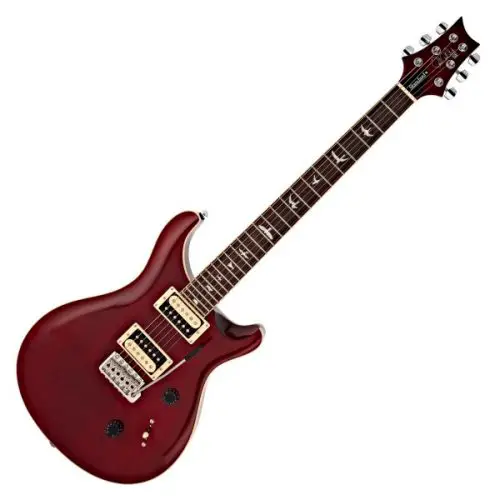
A wide-neck electric guitar suited for fat fingers is the PRS SE Standard 24. This is due to its wide-thin neck form, which offers you a firm but smooth grip on the neck and enables you to reach frets with ease regardless of how fat your fingers may be.
The neck is also made wider by the 1.69″ nut width which doesn’t feel like you’re carrying something heavy. It is hefty and yet properly suited under fatter or wider fingers.
Another feature is that the string spacing is 52,5mm (2.06″) wider than usual. 52mm is the Standard. Making the wrong notes difficult for you as a result. There is enough space for you.
The following are some advantages of the finest guitar for fat fingers:
- Superior sound is produced with high-quality pickups and tonewood.
- Versatility is increased by separate coil splits for both humbuckers.
- A wide, thin neck shape that is perfect for fat fingers.
- A scale length of 25 feet over 24 frets (hitting the wrong strings is made hard)
However, many people cannot afford it because of the exorbitant cost. Despite everything, this guitar has a meaty neck and a great sound. It is also very versatile.
FAQs
Are Skinny Fingers Better for Guitar?
Longer and skinny fingers are generally better for playing the guitar. However, with enough practice, anyone with shorter or fatter fingers can play any position that initially seems challenging just as easily.
This is why today, numerous talented guitarists with short or average fingers can play almost anything with no problems at all.
Can All Fingers Play Guitar?
All types of fingers can absolutely play the guitar. As you start out, you will have difficulty playing guitar, regardless of your finger size. So keep playing and focus on improving your skills instead.
Additionally, there are numerous sizes and varieties of guitars, from classical to electric. This guarantees that there is a guitar for your style of fingers. Find what works for you and maximize it.
Can Guitarist’s Fingers Grow?
A person’s finger will not grow by playing guitar alone. If your fingers are short and you play frequently, they won’t likely become longer.
Rather, your skills will continue to improve, and you will probably start to feel more at ease while playing the guitar.
As a result, with time and practice, your fingers will get stronger, more flexible, and more at ease when playing and not necessarily changing size.
Does Playing Guitar Thicken Your Fingers?
Playing guitar can slightly thicken fingers because they build calluses, which are basically an extra layer of dead skin that lessens the sensitivity in the areas where you make contact with the guitar forms, making you feel no pain.
Naturally, the first few days or weeks of playing can be extremely painful for your fingertips, but with time, all kinds of pain in your fingers will become tolerable, and you will be able to play for longer stretches of time. This proves that the fingertips will clearly thicken after a period of continuous playing.


